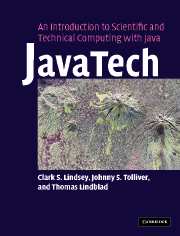Book contents
24 - Embedded Java
Published online by Cambridge University Press: 08 January 2010
Summary
Introduction
Although Java first gained fame with applets in Web browsers and then became a popular tool for creating large enterprise services, the developers of Java originally intended it for embedded applications in consumer devices such as TV remote controls and Personal Data Assistants (see Chapter 1). The term “embedded” generally refers to encapsulating a processor into a device, along with programs stored in non-volatile memory, to provide services and features specific to that device. Microcontrollers, for example, are the most common type of embedded processors.
By embedded Java we refer to a device that contains either a conventional processor running a JVM or a special type of processor that either directly executes Java bytecodes or assists a conventional processor with executing bytecodes. The motivations for device designers to embed Java depend on the particular device, but, in general, Java provides flexibility, interactivity, networking, portability, and fast development of the software for embedded projects.
Today several types of commercial devices come with Java built into them. As mentioned in Chapter 1, over 600 million JavaCards have been sold around the world as of mid-2004, and several hundred cell phone models include Java.
Embedded applications typically must deal with very limited resources. A full-blown J2SE application on a desktop with a Swing graphical interface might require several megabytes of RAM.
- Type
- Chapter
- Information
- Publisher: Cambridge University PressPrint publication year: 2005



